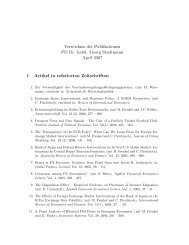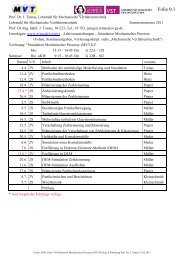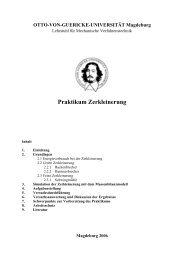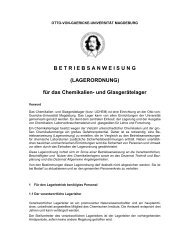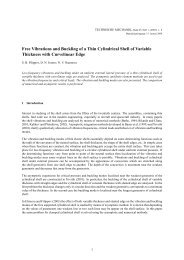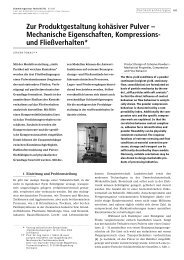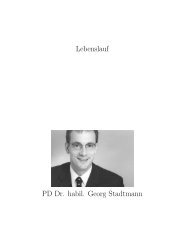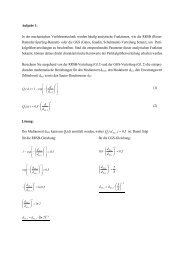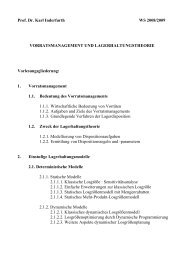38J. TomasFigure 9. Recalculated plastic contact deformation and sticking/bounce at central impact stressingusing data from Fig. 6. Two particles <strong>approach</strong> with velocities v 1 and v 2 , impact and the contact iselastic–plastically deformed (top panel). The inelastic deformation energy is dissipated into the contact.This is equivalent to the areas (gray tones) between the elastic–plastic boundary and <strong>adhesion</strong>boundary <strong>of</strong> the force–displacement lines which are obtained by integration (Eq. (91)). If the kineticenergy <strong>of</strong> these particles would be large enough, these particles can detach with rebound velocitiesv 1R and v 2R . The critical impact velocity for incipient yield <strong>of</strong> the contact is shown (Eq. (88)). Abovethis value, the two particles adhere or stick in practice, i.e., v 1R = 0. From this, the critical impact velocityv 1,H follows and is shown in the bottom panel versus particle center <strong>approach</strong> or displacementh K,U . The model <strong>of</strong> Hiller/Löffler predicts a constant velocity (Eq. (90)). However, practical experienceshows us that the faster the particles move and impact, the larger the contact displacement, andconsequently, the higher the tendency to stick. This is demonstrated by the curve <strong>of</strong> Eq. (93) in thebottom panel versus displacement h K,U .
<strong>Mechanics</strong> <strong>of</strong> <strong>nanoparticle</strong> <strong>adhesion</strong> — A <strong>continuum</strong> <strong>approach</strong> 39This can be rearranged if one uses the dimensionless plastic repulsion coefficientκ p according to Eq. (43) to obtain the following simple expression:v1,H,HL2( − ) 1/ 21 e a 6⋅p= ⋅ ⋅κ⋅2eF = 0 fdpρs(90)Unfortunately, Eq. (90) does not include the increase <strong>of</strong> “s<strong>of</strong>t” contact flatteningresponse h K by increasing particle impact velocity v 1 . Now this dominant energyabsorption W diss during particle impact stressing, beginning at any unloadingpoint U, is considered approximately as a trapezium-shaped area between elastic–plastic yield boundary and <strong>adhesion</strong> boundary for the contact <strong>of</strong> particles 1 and 2in the force–displacement diagram <strong>of</strong> Fig. 9. With the contribution <strong>of</strong> the work <strong>of</strong><strong>adhesion</strong> W A to separate this contact from equilibrium separation a F=0 to infinity,the energy balance gives (A K is the contact area):m212 ,2 2( )hKU, hKU,⋅ v − v = F ( h ) d h + −F ( h ) dh1 1R , N K K N,Z K KhKf, hKf,+ A ⋅ −p ( a) daK∞aF=0VdW( )3⋅pv v h h h a2 2 f2 21−1,R= ⋅ κA ⋅2K,U−K,f+ κp ⋅K,U⋅= 04⋅Fρs⋅r1,2(91)(92)The difference in characteristic impact velocities results directly in a center <strong>approach</strong>,h K,U , expressed by the unloading point U. The response <strong>of</strong> this contactdisplacement h K,U is a consolidation force, F N,U . Additionally, a certain preconsolidationlevel, F N,U , in a shear zone may affect the sticking/bounce probability.If the rebound velocity v 1,R = 0 the two particles will adhere. Consequently,the critical sticking velocity v 1,H is obtained without any additional losses, e.g.,due to elastic wave propagation:2 2( )3⋅pv = ⋅κ⋅ h − h + κ ⋅h ⋅af1,H 2 A K,U K,f p K,U 04 F =⋅ρs⋅r1,2(93)For example using data from Refs. [147, 149], this critical sticking velocity liesbetween 0.2 and 1 m/s for titania, curve in the sticking velocity–displacementdiagram in Fig. 9, which is equivalent to an average pressure level σ M,st = 2 to 18kPa (or major principal stress σ 1 = 4 to 33 kPa) [151]. These calculation results <strong>of</strong>particle <strong>adhesion</strong> are in agreement with the practical experiences in powder handlingand transportation, e.g., undesired powder blocking at conveyer transferchutes. In terms <strong>of</strong> powder flow the behavior after multiple stressing <strong>of</strong> s<strong>of</strong>t de-



